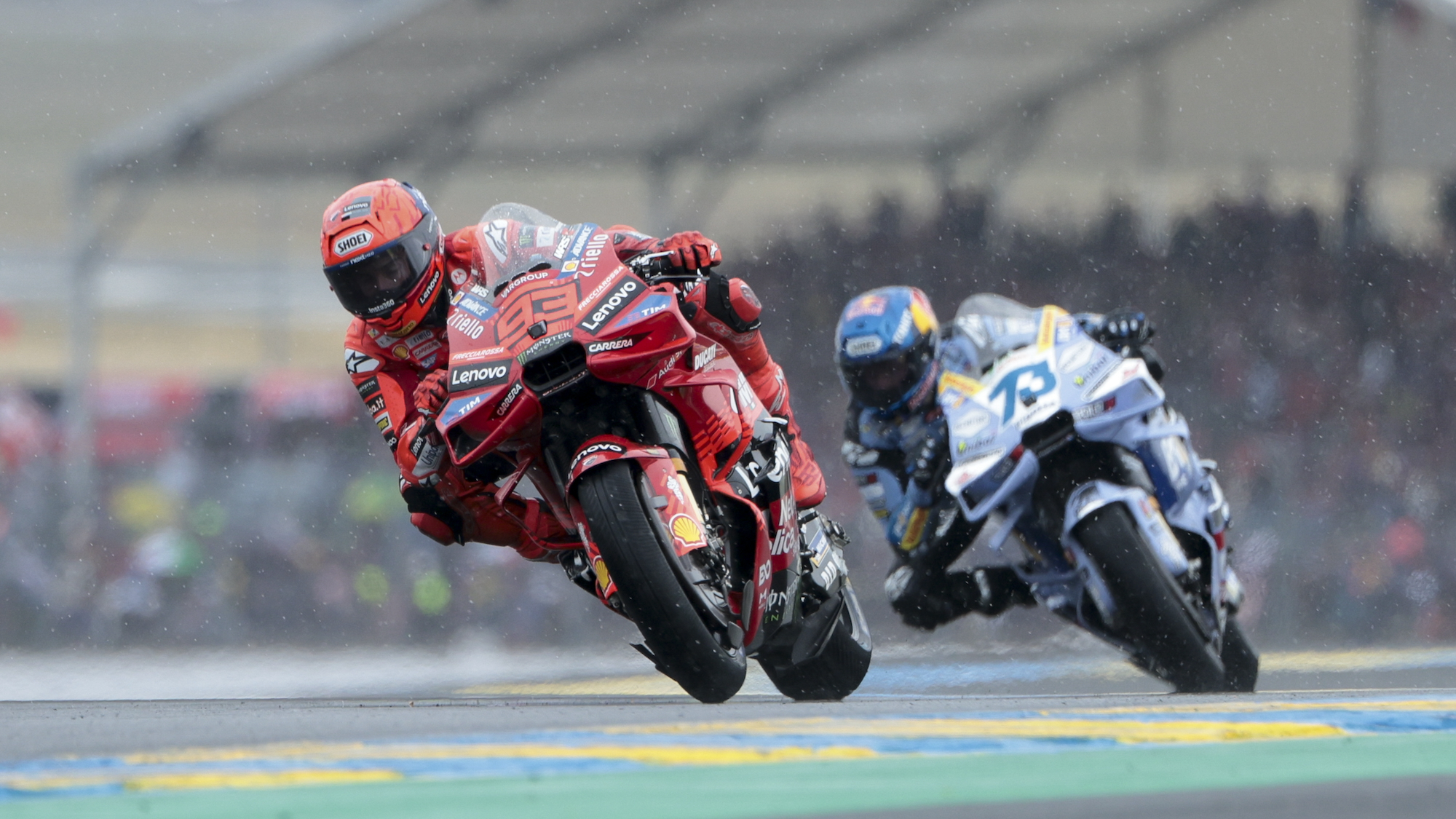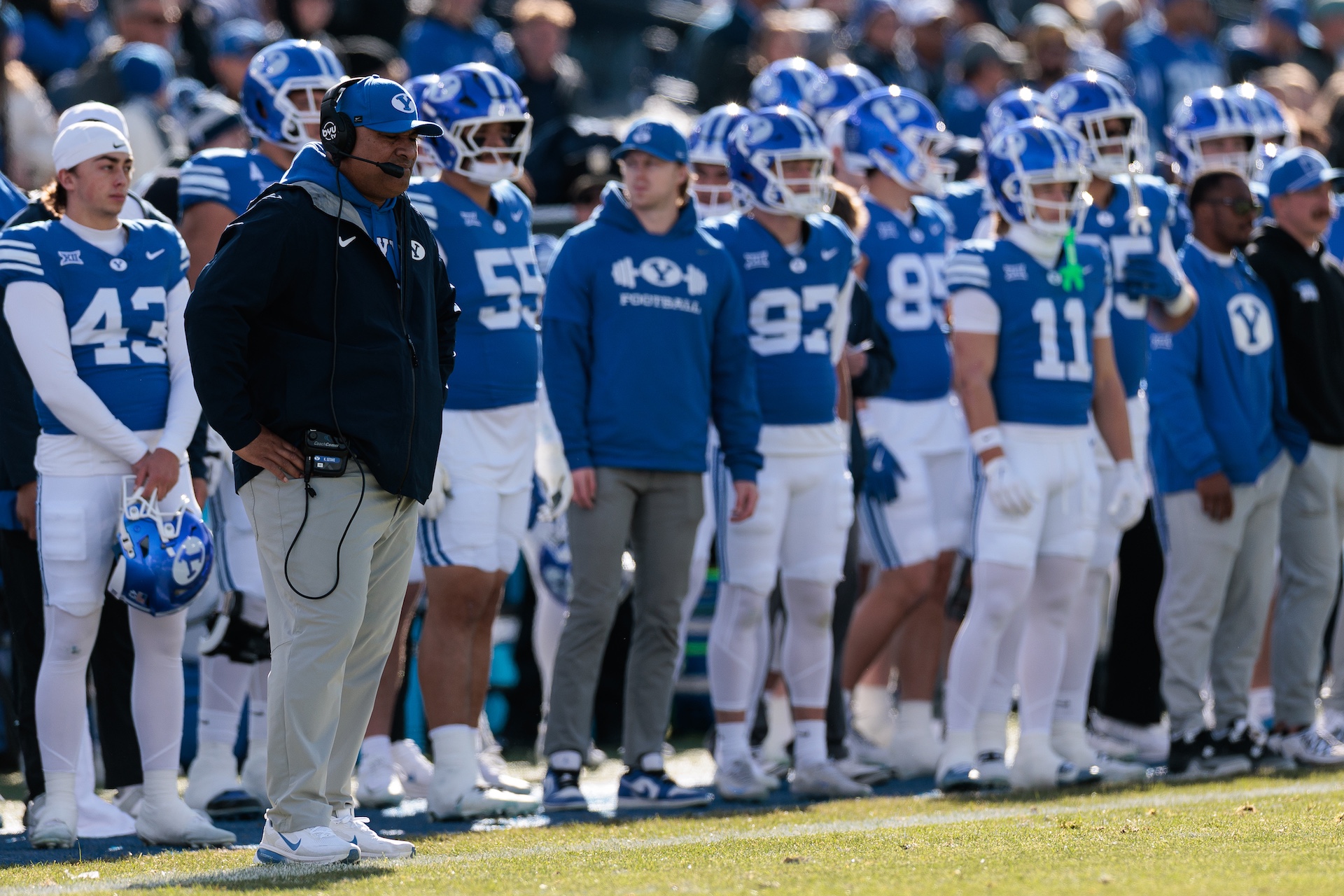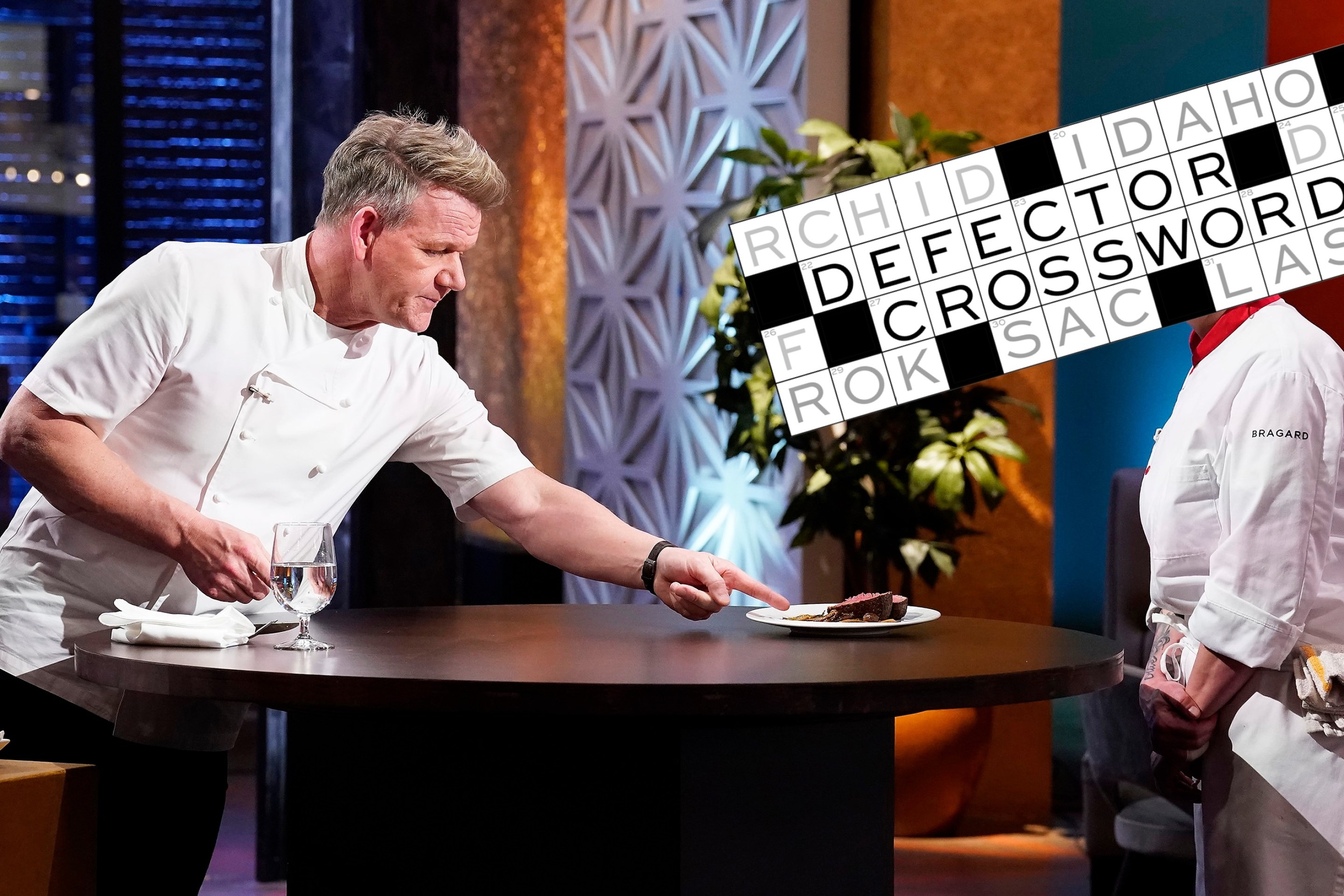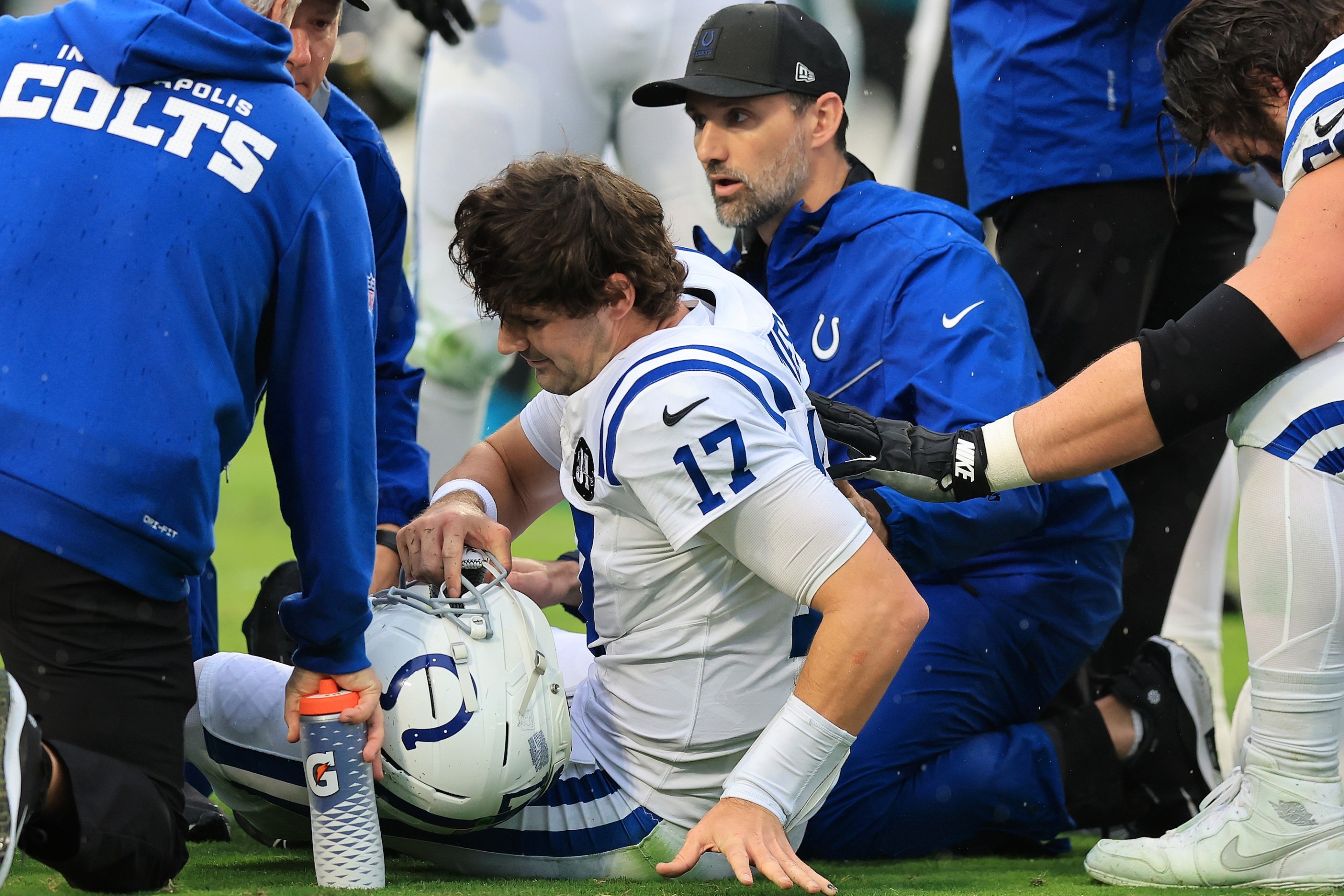LE MANS, FRANCE — The MotoGP championship standings table, going into the Grand Prix de France at Le Mans, was headed by two brothers of disparate levels of previous success. Marc Márquez, one point behind in second place, suffers from the elder child's plight of being shorter than his younger brother. Álex Márquez, the championship leader, suffers from the younger child’s plight of having an older brother who is considered by many to be the greatest of all time in their sport. You know how it is.
They have been on the same team twice. The first time was in 2020. Before that, between 2013 and 2019, Marc Márquez cemented the end of the Valentino Rossi dynasty. He became the youngest major champion in motorcyclesport, and then won five more championships on the back of his remarkably aggressive style. In his obscene 2019 season, he had one retirement, and otherwise finished top-two in every single race of the year. He accomplished all this without much help from his machinery: The Honda was broadly considered far from the best bike on the grid at the time. Like a lot of greats, Marc Márquez is either loved or resented, though the latter is no knock on his public demeanor. He is noticeably smiley. The same wide, full-faced grin has stayed with him from then, into 2020, and onto now.
In the first race to open the 2020 season, his home Spanish Grand Prix, Márquez crashed—not necessarily out of the norm for a rider who compulsively pushes the limit each lap—and broke his humerus. Three days after undergoing surgery, he attempted to enter the next race at the Andalucía Grand Prix, participating in a practice before declaring that his arm was in too much pain to continue. What "too much pain" means to an athlete is outside of anyone else’s conception.
Márquez's race record over the next few years was mottled by crashes and injury-related non-participations. In 2022, he had a fourth surgery on his humerus. Whatever knife's-edge balance or technique or instinct carried him to his championships was gone; these years were ruled over by riders trading championships, and the steady rise of Ducati as a constructor. So ended an era.
Then in 2024, Márquez—that is, Marc Márquez—finally left Honda to join his brother, again, at a Ducati satellite team, Gresini Racing. The Ducatis (Ducatti?) were now the de facto fastest bikes on the grid, though the satellite teams only receive the previous year's model. By a quirk of motorsport development, the satellite teams can occasionally be faster than the factory teams to start the season, though if this was the case in 2024, it was with eventual World Champion Jorge Martín's Ducati, rather than Marc Márquez's. Still, he got his first win since 2021, and his third-place finish in the championship was the best result he'd had in years; it was also his first full season since 2019. The next year—this year—he moved to the Ducati factory team proper.
The young upstart is now 32, the second-oldest regular rider on the grid. If the first Marc Márquez era ended with a broken arm in 2020, he now, given what might be the fastest bike on the grid for the first time in his long career, threatens a second. Take Marc Márquez away, and a viewer might not say that the 2025 Ducati bike looks the fastest on the grid: The 2024 Ducatis at Gresini have been performing the best, and Álex Márquez with them, and the theoretical third title contender riding the other 2025 Ducati, two-time champion Francisco "Pecco" Bagnaia, has spent the early part of the season struggling to keep up. Though Marc Márquez entered Le Mans in second by just one point, his name dominated the final race reports: pole position, fastest lap, and, if he didn’t crash, a win. So: It starts anew.
At the Friday practice session that really matters—the top 10 riders go straight to the final qualifying session, while the remainder have to fight it out for the two remaining places—Marc Márquez broke the all-time motorcycle lap record at Le Mans with a time of 1:29.855. Afterward, he was asked what he had learned from his crash in Jerez, Spain, the race prior. He gave a little laugh. "That I need to have this extra caution," he said. "I feel super confident. I feel smooth. I feel like I cannot crash, so. But, in the end, I need to realize that we're riding very fast. But I feel smooth, and then the lap times are coming in a good way. But ... it's difficult to explain, but I didn't feel the speed, that I'm riding super fast. Then sometimes I'm relaxing too much, but I need to be careful that the ..." A brief pause, connecting two otherwise seemingly unrelated thoughts. "We did the lap record today. So, yeah, I need to have this extra caution."
Out came the impression that he knew there was some care to be taken in concept, with some fuzziness on the practicalities of the idea. Perhaps that's the faint mental disconnect needed to become an all-time great who can accomplish the storied feat of outdriving his machinery, in a sport where people talk about crashing the bike in search of the limit like it is almost routine. Though Márquez is sure to clarify, "It's not like, 'OK, I will go here, and I will crash,' no."
It is easy—or easier—to see what makes Marc Márquez so great. The mechanics of car racing are obscured, but motorcycle racing is a visual medium, a treat for the eyes regardless of how boring the race; the viewer, at a certain point of education (i.e. the same level as mine) translates it using geometry. If you want a definition of pushing the limit, you can take a protractor and measure the impossible angles the riders cut to the ground. Catch the view from an on-bike camera, and you can measure the horizon, tilted slant, against the bottom of the television.
A rider navigates a fast chicane by torquing their body—and, correspondingly, the bike—about the wheels. Before a long turn, a rider braces out the inside leg, at more or less a right angle, foot sometimes skimming the ground—thanks to Valentino Rossi, who pioneered the now standard technique—before they tuck in and do not, at least in appearance, so much ride the bike as cling onto it. If they touch the ground, it is with a knee, not a foot. Or, if he is Jorge Martín (reigning champion; currently injured), he rides the corner on his arm. Cue the soundtrack: How low can you go?
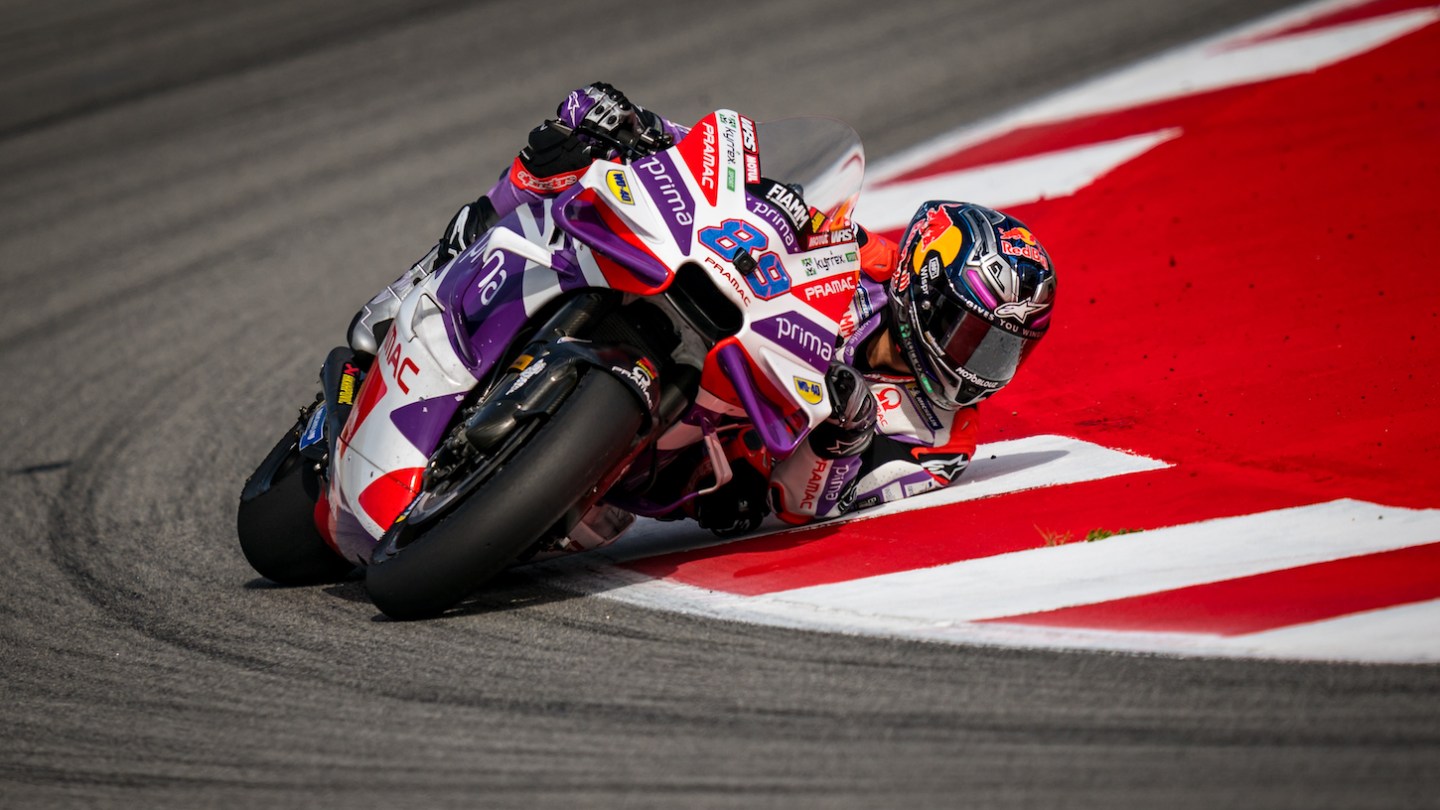
Everything about the sport feels faintly incorrect. The bike does not look quite like a bike, but like a science fiction–obsessed middle schooler's concept drawing of a bike. The riders, who have to wear the bulk of their protective material rather than outsourcing it to the vehicle, airbags distending their backs, barely cut a human silhouette. Motorcyclesport melds F1's brute force machinery with the bodily weirdness of cycling; pare the rider apart from the bike, and you reveal the silliness and brutality intrinsic to human flesh.
On a track built for cars, the rider-bike duo looks small. Crashes involve two separate entities—the human body and the motorcycle—and a prayer that they don't turn into an involved mechanics problem. A rider slides on his back after sliding out, and his boots kick up sparks. The camera mounted on the rear of the bike shows, well, the rear of the rider, helpfully emblazoned with a stylized name or nickname: Marc, El Diablo, things of that nature. During a practice start, the riders start with their legs poised like a leaping frog, attempting to corral the bike away from a wheelie. Riders swap bikes in the pits by hopping off one and shuffling more or less gracefully over to the other. The post-crash, post-error ritual involves an awkward run back to where bike and rider were cleaved apart and an imitation of theft away from the track marshals to start again, or, alternately, if circumstances allow, a run back to the pits. Fabio Quartararo's motorcycle runs out of gas at the end of the practice section? No worries. He can still ride it back and wave goodbye to the local fans as two track marshals push him along.
During breaks in sessions, the riders return to their equally brightly colored booths to sit and cool down. They unzip their race suits down the chest. Some wear a thin base layer underneath. For the others, it is only skin.
Saturday was hot by the standards of a European spring, with a high of 71-ish degrees and the dimensions of more temperate climates: pleasant jacket weather in the shade, T-shirt and shorts weather in the sun. In the morning, I made the same mistake as all the other people on the tram ride: I left at that time, a bit too late to be early. In preparation for the event, Le Mans had upped the frequency of their T1 tram line to every 10 minutes, which was not quite enough, or at least not enough for people unwilling to wait for the next one. The tram chugged along, overfilled, with prolonged delays at stops as more and more people crowded on. Then it hit a challenge: a slight uphill slope. The tram could not go up it. The passengers filed out, some to wait and some to walk—nearly 50 minutes to the final tram stop, longer to reach the heart of the track or paddock. Helpfully armed with the authority of reasonable company expenditure, I called a cab to go to the stop where the tram would've dropped me.
My cab driver was a Le Mans local. He went to the race as a child, but now he was working. He picked up, quite rapidly, that I was not from France, and upon learning I was from the United States, asked where from. I said Philadelphia, and before I could relate it geographically to New York City, he said, "Oh, Philadelphia!"
As it turned out, his mother had moved to Trenton, N.J., seven years ago. His sister lived in Toronto. "They say, 'Move over here, move over here,'" he told me. We shared an affection for Philly that, if not necessarily matched in depth or specific content, enabled us to relate. He loved boxing; he'd gone to take a photo at the Rocky statue with his son; he remembered visiting the African American Museum and then walking up two blocks and then … boom, Chinatown, with the—here we both made some gestures—arch. "Only in America," he said. After one day at the race and five days in France, I was poised to agree: Only in America.
We began to hit circuit traffic, and he let me off early to walk the rest of the way. I retraced the path I'd set the evening before, through the campsites (much quieter in the morning), and then I was at the MotoGP race in Le Mans again. You could tell by the demographic of people there, and how they engaged in the social activity of eye contact that turned into staring.
Oh, a brief reprieve: I passed by a member of a team who had helped me when I was lost the day prior, and we shared a joke, both pointing down the turn I had missed then. Then I was back among paddock VIPs.
Try not to take it personally. Anything and everything is a spectacle in the paddock, which is swarmed by media and staff and paddock VIP passholders and guests of sponsorship companies. Legitimate private space is scarce, which likely is why many thousands of fans consider a paddock pass to be worth it: Riders pass through on motorcycles, occasionally stopping for autographs or photos. On Friday, a sequence of French riders returned to the paddock from the practice session, and a French journalist listed out their names to me. There's Bagnaia, a faint enemy of the French people for winning a championship over local favorite Fabio Quartararo. One Moto3—third division—rider arrived on the back of another motorcycle, with his helmet on, both indications that he'd crashed. On Saturday, Formula 1 rookie Isack Hadjar was just walking about.
It is an environment one would imagine would be impossible to be inured to, yet some manage. There is not much choice, either way. You can go a long way with ignorance and consciously thinking about yourself less: I still don't know what that group of white Frenchmen said to me Friday evening, when we passed each other and they slowed, leaned over, and laughed. If a man says something, but those spoken to cannot understand it, does he open his mouth at all?
"Tough" was the word used by the French journalist to describe the typical MotoGP crowd to me. Even as MotoGP shares infrastructure with the institution of European motorsport, it hardly presents itself as a particularly elite endeavor. It is a much smaller ecosystem, and bears the marks of fewer eyes. This weekend's race does more to be affordable for families than I've seen anywhere else: Children under the age of 16 get in for free, for example, so long as they're accompanied by an adult with a ticket. The league has not yet evolved past grid girls—women in various outfits, depending on the team and sponsor, carry umbrellas in each rider's grid box. Someone passing through the media center makes a passing mention of Moto3, "where you don’t make much money at all."

A distillation of motorcyclesport's standing, in neither positive or negative slant, is that one second-division team's main sponsor is OnlyFans. The full government name is displayed on official media: OnlyFans American Racing Team.
Over the course of a MotoGP qualifying session, riders get more flying laps than their F1 counterparts. Like F1, qualifying sets the grid for the official, 20-plus lap race; unlike F1, qualifying also sets the grid for the 13-lap sprint race. Also unlike F1, each outing taken with at least one new tire—front and back tires can be mismatched in age and hardness—is usually worth at least two fast laps. Tire changes are a complicated process involving removing the brakes and altering the suspension, too time-consuming to be worth the diminishing returns of a few-lap fresher tires.
The first qualifying session matters, but it offers something of a Pyrrhic victory: The top two performers make it into the second qualifying session, where they have the chance to break into the top 10, but making it to that second session requires burning through at least an extra set of tires, leaving fewer good options for the point-scoring opportunities to come. The bikers who make the cut on this Saturday are Johann Zarco, a French rider for Honda, and Raúl Fernández, a Spanish rider for an American team, Trackhouse. After the second qualifying session, they end up with a final starting grid position of P11 and P10, respectively.
The real qualifying show almost inevitably winds up at the top. In this case, the show focuses on championship leaders Marc Márquez and Álex Márquez, and Quartararo, the local favorite. Quartararo won a championship of his own in 2021, and came close in 2022, when he lost to a Ducati, but has struggled in the midfield ever since. Even so, he's historically been good for one fast lap, even if Marc Márquez has routinely routed the field so far this season.
There's no way around it: The best way to watch a race is on television. Keeping up with all the action is impossible without multiple camera angles and a screen, and this is doubly true with the chained flying laps in qualifying—try updating and upkeeping the lap times of 10 riders at once to maintain some order in your brain. But the sound, in person. Armed with ear protection that can dampen the engine roar down below ear-damaging levels, it becomes a satisfying drone set to the rhythm of gearshifts. Close enough, behind a tire barrier slowly growing its own mini ecological environment, or loud enough—in the grandstands, a steep mass of stairs and metal scaffolding that captures and enhances the sound—you also feel it in your chest.
During qualifying, a woman sitting in the top row had a French flag rolled up beside her. It slipped away and tumbled down the steep stairs to the bottom platform, and she had to follow it, picking her way down in a more cautious manner. As it turns out, not so ill an omen. Marc Márquez held the fastest lap of qualifying for much of the session, a 1:29.442 in his second flying lap. Then Quartararo, in his last flying lap of the session, stole pole position away with a 1:29.324. The in-circuit French announcer, under no obligation to neutrality, broke into a cheer. The grandstands at the start-finish line erupted. Afterward, they sang the French national anthem for their guy.
"Being honest a bit with you, I missed a little bit my braking point in turn nine," Quartararo said. "I thought I was gonna crash in turn nine, but I was able to really stop well and make it." Thus was one of the margins, between crash and pole position. Though any celebration was necessarily short-lived. There was a sprint race to get to.
For those who complain that the cars are too big in F1, or that the on-track action of motorsport is not quite appealing in itself, here's a sport for you. For one, the bikes line up on the starting grid in threes, smaller grid-box notches overwriting the faded larger ones usually used for cars. You could comfortably fit five bikes astride on the track, though in practice it is a different matter.
Quartararo had a good start off the line in the sprint, but it quickly became clear that the Yamaha simply did not have enough power to keep up with the Ducati bikes behind—in order: Marc Márquez, and then Álex Márquez and Fermin Aldeguer in the Gresinis. Marc Márquez’s fellow teammate at Ducati, Pecco Bagnaia, sat in a more tepid sixth.
Because there are so many more overtaking opportunities in MotoGP, it is not so easy to tell, at first glance, where an overtake will occur or how easy it might be to make them stick. Riders can battle for corners, as Marc Márquez and Quartararo did, weaving inside, outside, back and forth. You could more or less track Quartararo's performance based on how many times the people beside me said putain. Marc Márquez managed to pass on lap six, and managed his pace from there to continue his perfect sprint-race win record in 2025. Quartararo, who simply didn't have the pace, was soon passed by both Gresinis: Álex Márquez and Aldeguer, who idolized Marc Márquez when he was young.

Marc Márquez cracked a joke after the session about being Mr. Saturdays but preferring to become Mr. Sundays. He also revealed some more insight into his style: "Normally when I ride on the limit, I feel the bike. When I don't ride on the limit, then I'm struggling more." Feel is how the riders describe it, always: some connection with what the machine is doing, how you know whether you are extracting enough from the bike, or if it is simply not working as it should.
Meanwhile his teammate, Bagnaia, spent the weekend lamenting the lack of feel he had with this year's bike. It was hard to brake; he never knew if the front would just give out on him. He crashed out of the sprint race in the second lap. No contact—the front of the bike slid out, and he slid along with it. Or, as Bagnaia simplified it, "I crashed."
Last year, he had been just 11 points away from a three-peat championship. Now he was teammates with Marc Márquez, in a bike that everyone would say is worse than last year's if not for Marc Márquez now leading the championship after winning the sprint. Even if Marc Márquez is not in the room, he is. "And Marc, another thing is that he can ride also a tractor and be competitive," Bagnaia said. "So in my case, it's not the same."
As it turns out, the issue with trying to grasp the entire race weekend in its entirety is that fate loves to play pranks. It is easier to isolate a narrative for a session or single event, but a race weekend is five different events chained together. There are the Márquez brothers, and then Quartararo, and the haunting of Bagnaia, and then: Sunday rain, wiping it all away, for riders and writers alike.
The full MotoGP race is shorter than in F1—pit stops are typically nonexistent, not to mention unnecessary, as a point of strategic intrigue—but it is also lonelier. Unlike racecar drivers, the riders are fully alone while they're on track: They wear ear protection on the bikes, and while there have been tests to try to implement radio, nothing has stuck. The only communication with the pit wall occurs through the pit board, where a member of the team arranges numbers and letters to communicate time and lap count and position and whether or not to box, and occasionally celebratory messages.
Le Mans has a similar reputation to the American Midwest, in that it is notoriously difficult to predict the weather there with much accuracy. Rain races pose a greater challenge for motorcycle racing, because of the impracticality of tire changes. A pit stop instead involves hopping off one bike onto a second bike, which is often less up to date than the original. At Sunday's race start, the weather was better described as "omnipresent dampness" than as "light rain," but the track started slippery. Thus began the comedic farce.
Every rider started the race on slicks, took their reconnaissance lap, and then returned for wet tires, the penalty for which was a pit lane start. Because too many riders (in this case, every single one) entered the pit lane, the race was red-flagged, giving time for the mechanics to fully change the tires on the original bikes. After a quick restart, the riders took another reconnaissance lap, after which they were, strictly speaking, forbidden from entering the pits. Even so, half the grid, including the Márquez brothers, ate a penalty to pit again, and hopped onto the bikes now bearing slick tires.
French hometown favorite Quartararo held onto the lead from the restart after the red flag, but crashed out in the early laps. He was later penalized for attempting to disobey the marshal's judgment that he could not resume racing. Pecco Bagnaia's accursèd weekend continued with a stroke of miserable luck, as he was taken out by Red Bull's Enea Bastianini in the very early running. As the rain intensified to "legitimate drizzle," the Márquez brothers both took a costly pit stop to hop onto the wet tires, leaving Johann Zarco in the lead. Álex eventually crashed out once and restarted, and then his broken bike made a second crash easy.
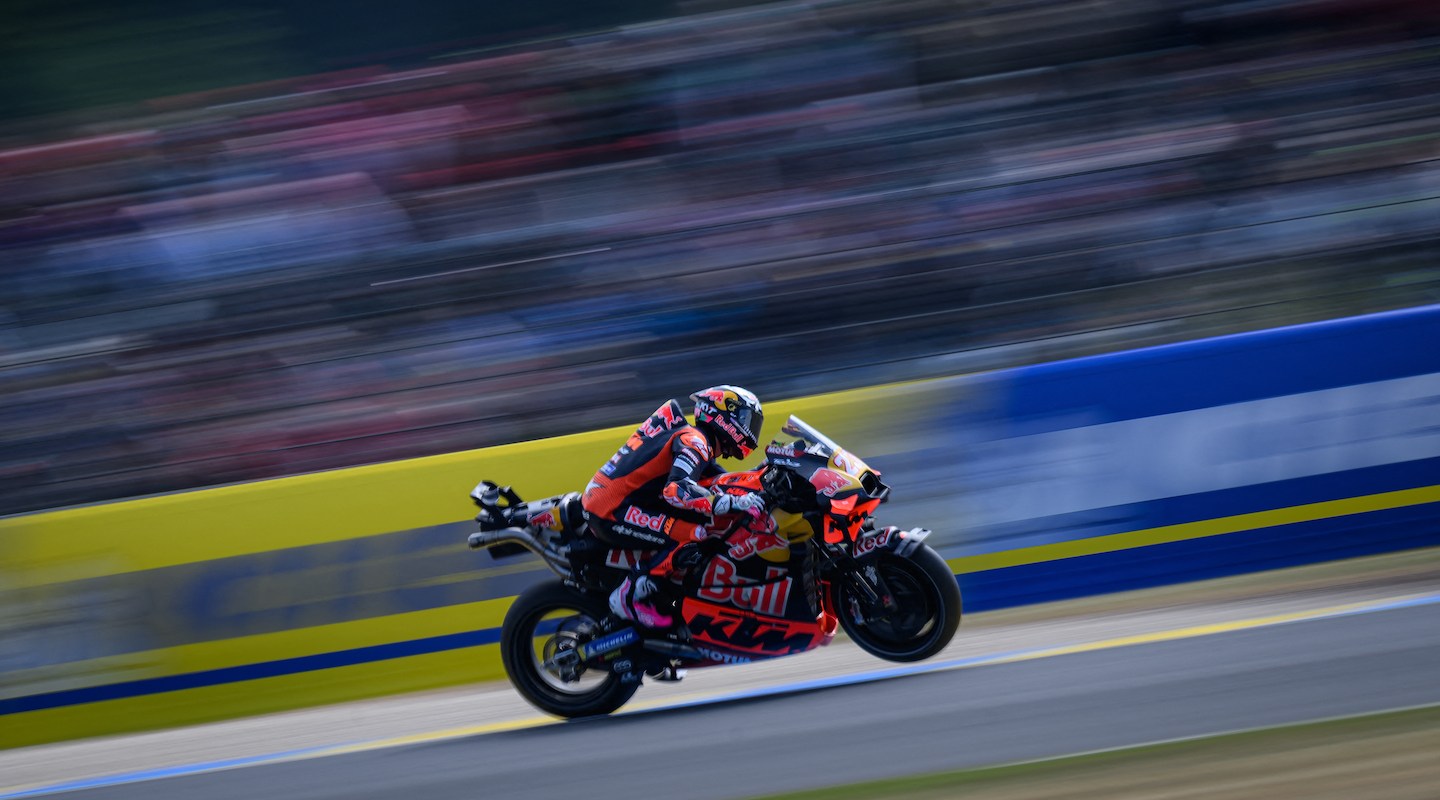
Marc held second behind Zarco to the end. He revealed later that he had weighed the risk of pushing against the probability of winning, and chose to play it safe instead: "The fact that I did a mistake in Jerez, avoid the mistake today. Because, if not, if I come with a victory from Jerez—I'm not 100 percent, but 80 percent sure that I will crash today, because I know myself." So the two biggest factions at the race—the French fans and the Marc Márquez fans—got a little bit of everything they wanted: The French crowd received the first French rider to win a home race since 1954, and Márquez was able to flex his newly acquired skill of foresight.
Johann Zarco! In a Honda! Nobody's pick to win the race, and, while French, a lesser homer favorite compared to Quartararo, whose motorhome was swarmed at all times of the day. The 34-year-old Zarco is the oldest on the grid, and prior to this weekend had only one race win to his name. He has a subdued demeanor paired with a blunt, impulsive-seeming honesty that makes him charming and funny, whether accidentally or intentionally. When asked about the crowd, he expressed both praise—the final count tallied to about 120,000 attendees on Sunday—and a strong desire to just be left alone at some point.
It would have to wait a little bit longer. The crowd rallied behind him after Quartararo's race ended and it became clear that Zarco was on for the win. Cheers followed him in a loop around the track. His parents came to watch him race, his mother for the first time in person, and he won. Even out of superstition, he wouldn't put them, especially his mother, through it again. An example Zarco quip: "I would not push her to have more white hair after 70 years."
In the immediate aftermath of an F1 race, it is only possible to spot the drivers' emotions in bits and pieces. A raised fists from the cramped cockpits of the vehicle; a cheer over the team radio; donuts, if the occasion is big enough to call for such indecorous behavior.
But in MotoGP, with so little barrier between the rider and, well, everything else, it becomes possible to bear witness, no matter that the rider's faces are similarly covered. Some classics: Joy is commonly expressed via wheelie, which is possible to pull off without stalling out the rest of the riders coming through. Teammates and friends on the grid slap each other on the back or helmet in congratulations, or even semi-embrace in movement—after finishing 1–2 in the sprint race, the Márquez brothers briefly rode side-by-side to do so. Employees and, occasionally, important civilians alike will swarm out onto the track in congratulations. If the race is a lonely one, just the rider and the bike, then that ultimate lap is when the bubble finally pops. The rider exists in the world again, and everyone shares it with him.
Perhaps it is an exaggeration to say that the final cooldown lap is the best part of the race, but it is the part with the most concentrated feeling. After winning in Le Mans, Zarco stopped his bike at the pit wall where his team climbed to smack him on the helmet. The local track marshals, job responsibilities temporarily set aside for patriotic euphoria, rushed the track, and Zarco slowed to a crawl to place his hand in theirs. One last demonstration of how the sport gets at the core of everything good, bad, gauche, beautiful: bodies, interfacing with other bodies.
